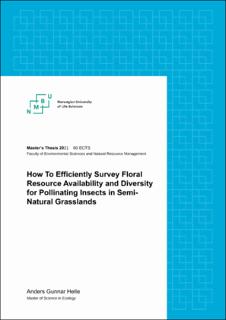| dc.description.abstract | Floral resources are the foundation for insect pollinators, on which we in turn rely on for food and ecosystem functioning. Global and regional trends show that insect pollinators become increasingly endangered with modernization and intensification of land use, and thus the need to find ways of conserving insect pollinators and their habitats become more crucial. There has yet to be developed an agreed upon standard practice for surveying floral resources to assess habitat quality for pollinators. Here, I provide much needed information on the pros and cons of the two most common sampling approaches; transects and plots, and three observational metrics; inflorescence counts, occurrence in subplots (frequency) and percentage cover estimates. The comparisons were based on three basic diversity indices: species richness, abundance, and the Shannon-Weiner diversity index. The results mainly depended on the observation metrics, not the sampling approach. Both plot-based methods, i.e., occurrence in subplots and percentage cover estimates, were superior to transects with inflorescence counts, both in species detection and robustness to differences in vegetation and biomass. Occurrence in subplots seemed less prone to overestimation of clustered species and thus provided diversity measures that were more representative of the species composition at the different sites than the two other methods. Future surveys of floral resources in semi-natural grasslands should be based on vegetative cover, in order to increase efficiency of the surveys by reducing the need for repeated sampling throughout the flowering season. Vegetation surveys should also take into account the practical implications of surveyor ability of detecting species by adjusting sample unit size to allow the surveyor to get a good overview of the plot. | en_US |

